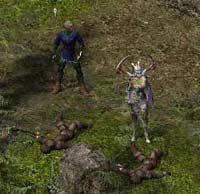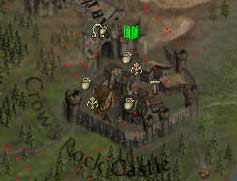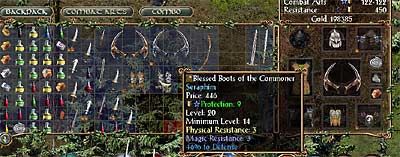Sacred
Brief Description of Sacred
With Sacred Underworld forms the Sacred Gold edition. This is the base game, without this the expansion will not work.
| Game style | Slash and hack |
|---|---|
| Combat type | Real time |
| Character Summary | Single character, prebuilt from one of 6 or 8 races. |
| Play mode | Supports single player and multiplayer modes |
| Game Controls | Point and click |
| Revitalise character | HP and magic will regenerate when not fighting |
| Quests | Several major quests and many optional minor ones. |
Evil has been let loose on your world and you are the only one who may stop it. While you may gather companions sometimes, you only control the main character.
The character selection gives you six choices: Battle Mage, Dark Elf, Gladiator, Seraphim, Vampiress, and Wood Elf. The character selection is crutial, once selected, the character will remain that class forever. The Gladiator and the Dark Elf do not use magic, though their special moves may appear that way. There is no specialisation of these characters; they have a race, sex, skin and hair colours preset by the class.
Game play and hints
Before you begin play, go online and download any updates for the game. If your game version is before 1.7, you really should get the updates first.
Battling through the world of sacred is pretty simple. You left click on an enemy to use your current weapon. You right click to employ special moves or magic.
The world in which you are playing is huge. It encompasses hills, mountains, desert and snow with farms, villages, castles and towns spread throughout. Any time you like, you can open the map to find the locations of known towns, portals, all finished quest locations and the major incomplete quest location. The map also has special icons for shops, blacksmiths, horse dealers and combination masters. Minor quests are flagged on the map once complete.
There are three levels of zoom available in the game, the game starts at the middle level, but you may either zoom out or zoom in. Zooming out is great for when you are exploring wilderness, you can see monster from much further away. Zooming in allows you to be right in the middle of the battle action. You'll get a chance to appreciate how the armor and weapons you have chosen are placed on your character. On the computer I've been using to do this review, zooming out in cities or towns is bad. It noticably slows the game.
The real workhorse of the game is the toolbar. The highlighted item on the left is the current weapon you have equipped. Select a different item to swap weapons and shields. Whenever you click on an enemy, this is what you'll be using. The highlighted item on the right is your special move, magic or combat art. When you right click, you'll use that. These moves must regenerate, and you can watch them recharging after use. The centre of the toolbar is the direction finder for your major quest (a large arrow) and any minor quests (small arrows). If you should happen to see a small red arrow moving, that means that you have a limited time to find and do some particular feat (such as save a family from goblins). Along the top of the toolbar are potion icons. Potions are colour coded and grey means you do not currently have any of that type. Other icons are for the map, your inventory, your log book and the game save/load/quit.
The game also features horses. I haven't used them too much, they can get stuck on terrain, you can't get a horse for a companion and I can't use my best skills when riding. But they are pretty good looking, you can ride down an enemy if you have a good horse and you can call them from almost an infinite distance away.
Gripes about Sacred
It worries me that there is no apparently penalty for dying in battle. You regenerate with full health, full experience and full inventory; granted somewhere other than where you just died with no easy way to return. I hate this, I keep expecting to notice something decrease when you die.
Monsters respawn a bit quickly in this game for my taste. After I have cleared an area once, I expect to be able to go through with relative (not complete) safety. You won't find this in Sacred. If you need to track through an area a second time, there will be nearly as many monsters as there were the first time. It may be that I failed to do enough side quests and monster slaying on my first time through the area though.
I hate having no control over the camera angles. There are times when it would be so much easier to play if you could move the camera around to see things from your character's point-of-view. Plus there is night/day, rain/shine and yet you never need to rest nor eat.
Conclusion for Sacred
Not for the faint of heart or slow of mouse. The battles are real-time and opening your inventory in battle could easily lead to death. Death lurks for the underprepared.
Quests in this game are pretty limited, they are mostly an excuse to send you to somewhere to kill something. Your character doesn't really interact with anyone in the world either. There aren't conversations, just information boxes with additional quests.
Now, having said this, I have enjoyed this game. I get annoyed when my Seraphrim dies suddenly. I wish it did have a bit more activity then go here, kill something, come back. But there is something very relaxing about the experience. Yes, someday my character will have to save the world from the evil released. In the meantime, let's just kill something!
Final rating 3.5 of 5.
Some final thoughts on the game.
I've been playing this as a lunch time game and a coworker asked if I usually spend so long in a game before I review it. The answer is generally yes, I spend a couple of days with any game real time before I review. I want to give the game a reasonable chance to impress and to be certain that what I say is accurate (from my perspective). Adventure games I tend to finish before I review, but RPGs take ages to finish and so I try to review when I feel I've experienced enough.



